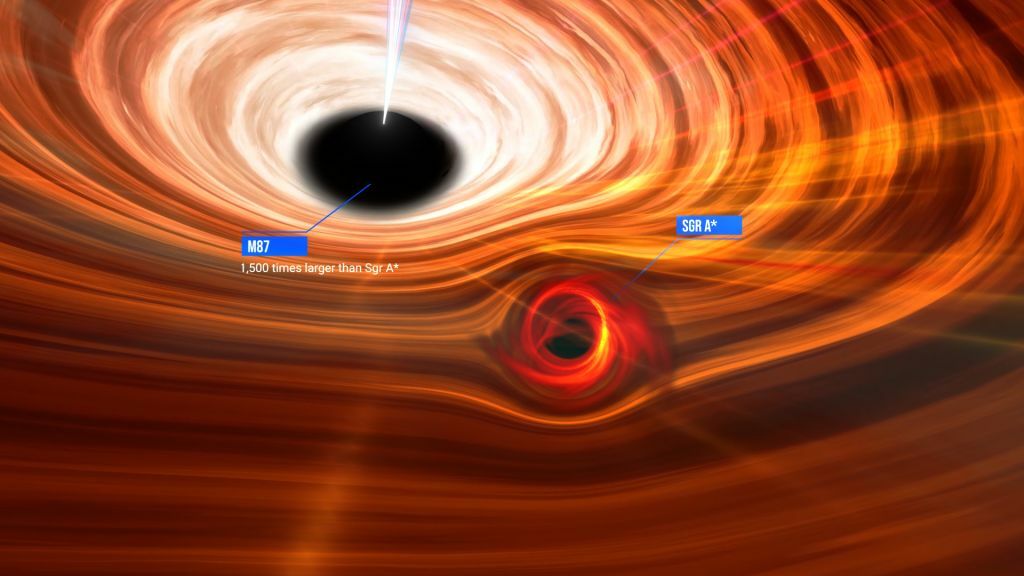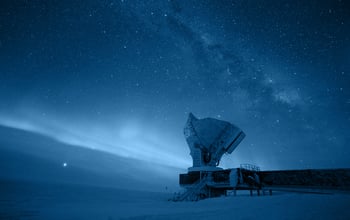Astronomers have at long last seen the center of the Milky Way galaxy, unmasking a giant black hole, a celestial vortex 26,000 light-years from Earth that should otherwise be hidden from sight.
An international team of researchers released on Thursday a snapshot of the supermassive black hole known as Sagittarius A*, spied through the power of eight linked radio dishes from around the world that together can penetrate through gas clouds in outer space. Though black holes are by definition unseeable — light can’t travel fast enough to escape their clutches — Sagittarius A* revealed itself in the form of a black shadow surrounded by the bright glow of the gas and debris swirling around its perimeter.
The photo showed a region in deep space reminiscent of a solar eclipse — a darkened circle, wreathed in a radiant red-orange fuzz of light. The image was colorized so that human eyes could perceive it.
Up until three years ago, any depiction of a black hole was merely an artist’s interpretation or a computer model of what the spinning, spacetime-bending phenomenon might look like. This object, seen in the photo at the top of this story, is the real deal, each pixel representing a Herculean effort: hundreds of scientists from 80 institutions around the globe, working together to collect, process, and piece together fragments of data.
The breakthrough was also published in the science journal Astrophysical Journal Letters. Spokespeople from the Event Horizon Telescope, the international collaboration of 300 scientists who worked on the feat, hosted simultaneous press conferences in at least seven countries to share the news, including the United States at the National Press Club in the nation’s capital.
The image of Sagittarius A*, pronounced “Sagittarius A-Star,” is a monumental achievement, the second such time scientists have overcome the barrier of invisibility to glimpse a black hole. The first photo, revealed in April 2019, showcased the black hole that resides at the center of the Messier 87 galaxy, an easier target to capture because of its size, despite its being much farther, at about 53 million light-years away. Astronomers say that black hole, dubbed M87*, is as large as Earth’s eight-planet solar system.
The second photo provides powerful confirmation to the scientific community, said Feryal Özel, a professor of astronomy and physics from the University of Arizona.
“Now we know that it wasn’t a coincidence — it wasn’t some aspect of the environment that happened to look like the ring that we expected to see,” she said at the news event in Washington, D.C. “We now know that, in both cases, what we see is the heart of the black hole, the point of no return. These two images look similar because they are the consequence of fundamental forces of gravity.”

This graphic shows how much larger the supermassive black hole in the galaxy M87 is than Sagittarius A* (which lies at the center of our Milky Way galaxy).
Credit: National Science Foundation / Keyi “Onyx” Li
Sagittarius A*, or Sgr A* for short, is considerably smaller, at some 27 million miles across, but it’s no pipsqueak. Scientists estimate it to be 4 million times more massive than the sun. To make a difficult number to grasp even more unfathomable, imagine this: The sun’s mass is equal to 333,000 Earths.
Its Milky Way home, a spiral galaxy, is fairly flat, but the center sinks down where the supermassive black hole sits. All around it are stars zipping in varied directions. But the hole, often anthropomorphized in pop culture as a space monster, is actually quite “gentle,” researchers say, consuming relatively little from its environment.
Black holes are some of the most elusive things in outer space. The most common kind, called a stellar black hole, is often thought to be the result of an enormous star dying in a supernova explosion. The star’s material then collapses onto itself, condensing into a relatively tiny area.
But how supermassive black holes, millions to billions of times more massive than the sun, form is even more mysterious than typical stellar black holes. Many astrophysicists and cosmologists believe these behemoths lurk at the center of virtually all galaxies. Recent Hubble Space Telescope observations have bolstered the theory that supermassive black holes get their start in the dusty cores of starburst galaxies, where new stars are rapidly churned out, but scientists are still chipping away at the problem.
Black holes don’t have surfaces, like on a planet or star. Instead, they have a boundary called an “event horizon,” It’s a point of no return. If anything swoops too close, it will fall in, never to escape the hole’s gravitational pull.

Credit: Chip Somodevilla / Getty Images
If M87* offered proof that black holes weren’t science fiction, Sgr A* is the testament to decades of mounting observational science. Prior to the first black hole photo, scientists inferred a hole’s presence in space by detecting its impact on nearby stars and gas. Albert Einstein, whose theory of general relativity predicted black holes over a century ago, and Stephen Hawking, a cosmologist who devoted much of his career to mathematically proving their existence, are among the many figures who paved the way for Thursday’s revelation.
If M87* offered proof that black holes weren’t science fiction, Sgr A* is the testament to decades of mounting observational science.
Sgr A* is exciting to scientists because it’s ordinary, said Michael Johnson of the Harvard Smithsonian Center for Astrophysics. the central supermassive black hole is representative of many others in the universe, allowing experts to learn more about these mysterious space objects.
Despite their visual similarities — a flaming doughnut versus another flaming doughnut — the two black holes couldn’t be more different, scientists said. M87* is accumulating matter at a significantly faster rate, but the Milky Way’s central black hole changes in appearance more quickly: It takes mere minutes for gas to fully orbit it, whereas an orbit around its predecessor lasts about two weeks.
Moreover, the first photographed black hole launches a humongous jet of radiation that extends as far as the edge of its galaxy, while Sgr A* does not.
To collect the massive amount of data needed to process the new image, the Event Horizon Telescope used a technique called very-long-baseline interferometry, which syncs up observatories around the world and takes advantage of Earth’s rotation to form one virtual planet-sized telescope. Together, the instruments were able to view the sky with sight on par with that needed to read a newspaper in New York from Paris, according to the organization.
At the time of the 2019 black hole announcement, Event Horizon Telescope collaborators said they had attempted to create an image of this supermassive black hole as well, but the team hadn’t been able to get a clear picture. As one of the most studied supermassive black holes in the universe, that came as a disappointment to many astrophysicists who yearned to gaze at our galaxy’s own navel.
“For me personally, I met it 20 years ago and have loved it and tried to understand it since,” Özel said Thursday.
This time around, scientists added the South Pole Telescope, which wasn’t used in the M87* photo, to the virtual telescope array to improve the resolution of their imaging. Researchers gathered five petabytes-worth of data, about 2.5 trillion pages of printed text, to catch even a glimmer of this black hole, said Dom Pesce, a member of the telescope team.
Put another way, that’s the equivalent amount of data in about 100 million TikTok videos, said Vincent Fish, a research scientist at MIT Haystack Observatory. That’s way too much to stream over the internet, so scientists had to ship hundreds of hard drives to two centers in Western Massachusetts and Bonn, Germany, where supercomputers could crunch the raw data.

Credit: Daniel Michalik / National Science Foundation
Admittedly, the Sgr A* photo is blurry. Johnson likened the blur to peering through frosted glass. Radio waves containing crucial image details are scattered, making the hole’s sharp outline look more like a jelly ring. To fix that, the telescopes either need to be farther apart or reach higher frequencies, he said.
“We don’t think that the black hole is actually a blurry image on the sky,” Johnson said. “We’re just at our breaking point here.”
“We don’t think that the black hole is actually a blurry image on the sky.”
With financial support from the National Science Foundation and other groups, scientists plan to enhance their technology to make the image drastically sharper.
Another next step for the collaboration is to attempt to turn these still images into videos, so that scientists can observe how gas is falling toward the black holes’ event horizons. That project could be completed sometime after 2024, they said.
But in case anyone out there is underwhelmed by another flaming doughnut, Katie Bouman, an assistant professor of astronomy at Caltech, had a reminder about just how much data is packed into the picture.
“This image is actually one of the sharpest images you’ve ever seen,” she said.